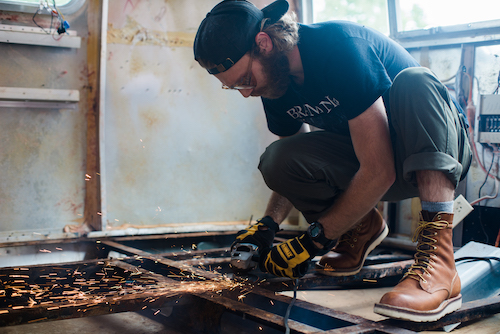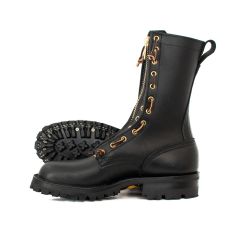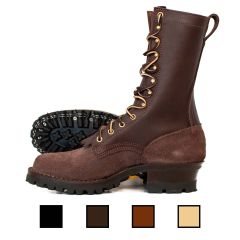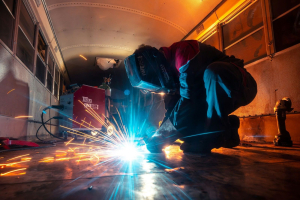Why Are My Work Boots Killing My Feet?
My Work Boots Are Killing My Feet...Here's Why That's Happening
You've probably worn a pair of boots for work or for other purposes and after a few hours you're thinking "my work boots are killing my feet." Let's talk about why that happens.
Foot pain can manifest for a number of reasons, and a good number of them need to be addressed by an actual doctor. If you're having chronic footpain, new boots alone aren't the cure; you should see a podiatrist. This isn't medical advice and we aren't doctors.
However, the usual suspects, so to speak, are fairly well-known when it comes to why your feet hurt when you wear work boots, outdoor boots or what have you. Here's what they are.
Your Work Boots Don't Have Enough Arch Support
Probably the most common source of foot pain is not having enough arch support. It's common for leather work boots, it's common with athletic shoes and all types in between.
The arch is the spring of the foot. It compresses, then releases as you push off with the ball of the foot and the toes. Now, your foot has a unique shape due to your genes; some people have a high arch and others have a low arch. Yours might be perfectly typical or not.


When you wear any shoes, the foot is constrained inside it and may not flex as much as it normally would if you were barefoot. To compensate for how shoes affect the motion of your feet, the arch has to be supported with additional material or has to have space to flex more under compression.
Some people need more arch support, some people need less. That's why some people took so well to the "barefoot" shoe craze and others just found them painful.
The sure sign of insufficient arch support is soreness at the front of the heel on the bottom of the foot. A lot of people believe it's from impacts or "being on your feet too long," but it often isn't. It's because your boots or shoes don't support your arch well enough for your feet.
Work Boots Can Give You A Sore Heel If They Don't Absorb Impact
That said, you can get a sore heel because enough force is being directed into them.
The reason that happens is because the boots or shoes you're wearing aren't absorbing the force of your feet walking around on the surfaces you're walking on. It's terribly obvious if you're on concrete all day or in rough terrain because you work outdoors.
The reason why? It's fairly simple; usually there isn't enough material there or the material that is there just doesn't take the pounding.
This is why wedge sole work boots and logger-style boots are so popular as work boots. Thick soles reduce the impact incredibly well, keeping people more comfortable walking on hard surfaces.


Another common reason is that you just aren't finished breaking your work boots in. New leather can be stiff!
There are two key processes that are happening when you get new leather boots.
First, the upper has to be worn so that certain areas "break" over your feet. What's actually happening is the leather in those areas is stretching over your foot. The usual spots are the heel cup (called the "counter") the "back stay" (the rib of leather going up above the heel) and the corners of the upper where they meet the toe box, which is called the "blucher."
Second, the footbed - the structure underneath your foot - is getting the shape of your foot pounded into it by walking.
And why does this matter?
You'll notice pinching and rubbing at the heel and the backstay (a lot of people wear thick socks and/or carry bandages for break-in) and at the blucher. You'll usually notice a bit of pinching at the widest part of your foot, either by the big toe or the pinky toe.
The footbed will feel hard at first, so you may get sore feet at first.
The hardier the construction, the longer the process takes. If it takes you a while to break boots in, that means you've bought some heavy-duty work boots that should last quite a while...and will feel amazing once they are.


Ever worn a shirt or pants that are a half-size or even a full-size too small? You can fit in them, but they aren't very comfortable...and that's the same problem some people have with boots and shoes.
Boots and shoes are made using a mold called a "last." The lasts that every company uses is unique, and so therefore are their sizes relative to actual foot measurements. Sure, the company that makes them calls them an "11" or what have you...but that's based on their version of what a "size 11" is.
And as with so many other things in life, a lot of people find out "good enough" really isn't.
A bad fit will cramp your toes, pinch, and interfere with your feet acting as they should anatomically. At first it's just discomfort, but can eventually lead to injury.
You should know what the measurements of your feet actually are, and what your true size is. That will at least give you a baseline, and help you find what your size actually is from a bootmaker or shoe company's size guide.
It's always the best idea to get fitted for boots, if you can. Bespoke boots and shoes (meaning made to order, for your measurements) will give you the best fit and therefore the best results in terms of comfort. A lot of people endure a lot of misery before they figure out they're buying the wrong size.
So start by getting fit. You'll be a lot more comfortable on your feet for it.








Validate your login